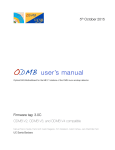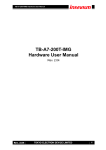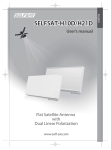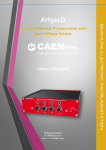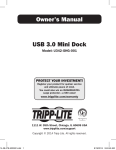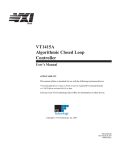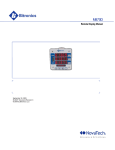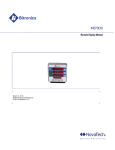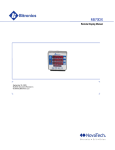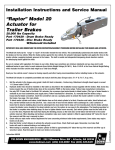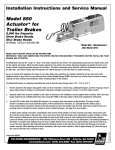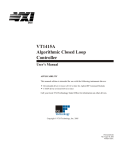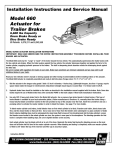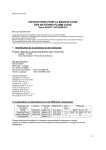Download ODMB user`s manual
Transcript
23th January 2014 ODMB user’s manual Optical DAQ MotherBoard for the ME1/1 stations of the CMS muon endcap detector Firmware tag: V02-04 ODMB.V2 and ODMB.V3 compatible Manuel Franco Sevilla, Frank Golf, Guido Magazzù, Tom Danielson, Adam Dishaw, Jack Bradmiiller-Feld UC Santa Barbara ODMB user’s manual Table of Contents Front panel 2 General 3 3 3 4 Firmware version VME access through the board discrete “emergency” logic Jumpers and test points Device 1: DCFEB JTAG Example: Read DCFEB UserCode Device 2: ODMB JTAG Example: Read ODMB UserCode Device 3: ODMB/DCFEB control Bit specification of ODMB_CTRL and DCFEB_CTRL Information accessible via command “R 3YZC” Device 4: Configuration registers Notes Device 5: Test FIFOs Notes 5 5 6 6 7 7 8 9 9 10 10 Device 6: BPI Interface (PROM) 11 Device 7: ODMB monitoring Translation into temperatures and voltages 12 12 Device 8: Low voltage monitoring 13 Device 9: System tests 14 Firmware block diagram 15 i ODMB user’s manual Front panel Push buttons HRST: Reloads firmware in PROM onto FPGA SRST: Resets registers/FIFOs in FW. LEDs 1-12 A blink at different speeds for ~3s PB1: Sends L1A and L1A_MATCH to all DCFEBs. Turns on LED 12 LEDs set in firmware 1: 4 Hz signal from clock for data → DDU 3: 2 Hz signal from clock for data → PC 5: 1 Hz signal from internal ODMB clock ODMB HRST 7: Data taking: ON normal, OFF pedestal 9: Triggers: ON external, OFF internal 11: Data: ON real, OFF simulated SRST 2: Bit 0 of L1A_COUNTER DDU 4: Bit 1 of L1A_COUNTER PC B 6: Bit 2 of L1A_COUNTER 8: Bit 3 of L1A_COUNTER 10: Bit 4 of L1A_COUNTER 12: Briefly ON when a VME command is received. Also ON when PB1 is pressed LOCK ERR DDU LEDs set in hardware DDU: Signal Detected on DDU RX PC: Signal Detected on PC RX 5.0V 1.0V LVMB FPGA 1.2V FPGA 1.8V 2.5V FPGA FPGA 3.3V FPGA EJD: JTAG enable for discrete logic (active low) PC ETD: DTACK enable for discrete logic (active low) DON: DONE signal from FPGA. ON when pro- 3.3V OTX 3.3V ORX 3.3V ORX1 grammed 5.0V VME 3.3V VME 3.3V PPIB LOCK: QPLL is locked INIT: INIT_B signal from FPGA (active low) ERR: Error with QPLL Bottom 12: Voltage monitoring Firmware tag: V02-04 2 ODMB user’s manual General Firmware version For a given firmware tag VXY-ZK: ❖ ❖ Usercode is XYZKdbdb Firmware version read via “R 4200” is XYZK VME access through the board discrete “emergency” logic The FPGA may be accessed via JTAG through the discrete logic as follows ❖ ❖ ❖ The VME address is 0xFFFC The bit 0 of the data sent is TMS The bit 1 of the data sent is TDI For example, to read the Usercode, starting from JTAG idle (five TMS = 1 & one TMS = 0), the commands are: W W W W FFFC FFFC FFFC FFFC 1 1 0 0 To To To To Select-DR-Scan Select-IR-Scan Capture-IR Shift-IR W W W W W W W W W W FFFC FFFC FFFC FFFC FFFC FFFC FFFC FFFC FFFC FFFC 0 0 0 2 0 0 2 2 2 3 Shifting Shifting Shifting Shifting Shifting Shifting Shifting Shifting Shifting Shifting W W W W FFFC FFFC FFFC FFFC 1 0 1 0 To To To To W R FFFC FFFC 0 0 Shifting DR Shifting DR (Read bit 0 of UserCode) IR (Read UserCode IR = 3C8) IR IR IR IR IR IR IR IR IR and to Exit1-IR Update-IR Run_Test/Idle Select-DR-Scan Capture-DR Since the Usercode register is 32 bits, the last two commands should be repeated 31 more times. Firmware tag: V02-04 3 ODMB user’s manual Jumpers and test points Place the jumpers marked in red in the diagram. The signals sent to the test points marked in blue are: TP12 RAW_LCT(1) TP13 L1A_MATCH(1) TP30 Defined by TP_SEL TP31 TP14 RAW_LCT(2) TP15 L1A_MATCH(2) TP32 TP33 TP16 RAW_LCT(3) TP17 L1A_MATCH(3) TP34 Defined by TP_SEL TP35 TP18 RAW_LCT(4) TP19 L1A_MATCH(4) TP36 TP37 TP20 RAW_LCT(5) TP21 L1A_MATCH(5) TP38 Defined by TP_SEL TP39 TP22 RAW_LCT(6) TP23 L1A_MATCH(6) TP40 TP41 TP24 RAW_LCT(7) TP25 L1A_MATCH(7) TP42 TP43 TP26 L1A TP27 DDU_DATA_VALID TP44 TP45 TP28 OTMBDAV TP29 ALCTDAV TP46 DCFEB_TDI TP47 2.5V TP48 DCFEB_TMS TP49 Defined by TP_SEL XILINX VIRTEX-6 XC6VLX130T FFG1156 Firmware tag: V02-04 4 ODMB user’s manual Device 1: DCFEB JTAG “Y” refers to the number of bits to be shifted Instruction Description W 1Y00 Shift Data; no TMS header; no TMS tailer W 1Y04 Shift Data with TMS header only W 1Y08 Shift Data with TMS tailer only W 1Y0C Shift Data with TMS header & TMS tailer R 1014 Read TDO register W 1018 Resets JTAG protocol to IDLE state (data sent with this command is disregarded) W 1Y1C Shift Instruction register W 1020 Select DCFEB, one bit per DCFEB R 1024 Read which DCFEB is selected Example: Read DCFEB UserCode DCFEB registers are set and read via JTAG. The following procedure reads the 32-bit USERID of DCFEB 3: W 1020 4 W W R W R 191c 1F04 1014 1F08 1014 3C8 0 0 0 0 Firmware tag: V02-04 Select DCFEB 3 (one bit per DCFEB) Set instruction register to 3C8 (read UserCode) Shift 16 lower bits Read last 16 shifted bits (DBDB) Shift 16 upper bits Read last 16 shifted bits (XYZK) 5 ODMB user’s manual Device 2: ODMB JTAG “Y” refers to the number of bits to be shifted Instruction Description W 2Y00 Shift Data; no TMS header; no TMS tailer W 2Y04 Shift Data with TMS header only W 2Y08 Shift Data with TMS tailer only W 2Y0C Shift Data with TMS header & TMS tailer R 2014 Read TDO register W 2018 Resets JTAG protocol to IDLE state (data sent with this command is disregarded) W 2Y1C Shift Instruction register W 2020 Change polarity of V6_JTAG_SEL Example: Read ODMB UserCode Read FPGA UserCode: W W R W R 291c 2F04 2014 2F08 2014 3C8 0 0 0 0 Firmware tag: V02-04 Set instruction register to 3C8 (read UserCode) Shift 16 lower bits Read last 16 shifted bits (DBDB) Shift 16 upper bits Read last 16 shifted bits (XYZK) 6 ODMB user’s manual Device 3: ODMB/DCFEB control Instruction Description W/R 3000 ODMB_CTRL register W/R 3010 DCFEB_CTRL register W/R 3020 TP_SEL register (selects which signals are sent to TP27, TP28, TP41, TP42) W/R 3100 LOOPBACK: 0 → no loopback, 1 or 2 → internal loopback W/R 3110 DIFFCTRL (TX voltage swing): 0 → minimum ~100 mV, F → maximum ~1100mV R 3120 Read DONE bits from DCFEBs (7 bits) R 3124 Read if QPLL is locked R 3YZC Read ODMB_DATA corresponding to selection YZ (see below) Bit specification of ODMB_CTRL and DCFEB_CTRL ‣ ‣ ‣ ‣ ‣ ‣ ‣ ‣ ‣ ‣ ‣ ‣ ‣ ‣ ‣ ‣ ‣ ‣ ‣ ODMB_CTRL[3:0] - Selects CAL_TRGEN (calibration mode). ODMB_CTRL[4] - Selects CAL_MODE (calibration mode). ODMB_CTRL[5] - Selects CAL_TRGSEL (calibration mode). ODMB_CTRL[7] - Selects DCFEB data path: 0 → real data, 1 → dummy data. ODMB_CTRL[8] - Resets FPGA registers/FIFOs and LEDs 1-12 blink for ~3s. Bit is auto-reset. ODMB_CTRL[9] - Selects L1A and LCTs: 0 → from CCB, 1 → internally generated. ODMB_CTRL[10] - Selects LVMB: 0 → real LVMB, 1 → dummy LVMB. ODMB_CTRL[11] - Kills L1A. ODMB_CTRL[12] - Kills L1A_MATCH. ODMB_CTRL[13] - 0 → normal, 1 → pedestal (L1A_MATCHes sent to DCFEBs for each L1A). ODMB_CTRL[14] - 0 → normal, 1 → pedestal (OTMB data requested for each L1A, needs spec. OTMB FW). DCFEB_CTRL[0] - Reprograms the DCFEBs. Bit is auto-reset. DCFEB_CTRL[1] - Resynchronizes the L1A_COUNTER of ODMB and DCFEBs. Bit is auto-reset. DCFEB_CTRL[2] - Sends INJPLS signal to DCFEBs. Bit is auto-reset. DCFEB_CTRL[3] - Sends EXTPLS signal to DCFEBs. Bit is auto-reset. DCFEB_CTRL[4] - Sends test L1A and L1A_MATCH to all DCFEBs. Bit is auto-reset. DCFEB_CTRL[5] - Sends LCT request to OTMB. Bit is auto-reset. DCFEB_CTRL[6] - Sends external trigger request to OTMB. Bit is auto-reset. DCFEB_CTRL[7] - Resets the optical transceivers. Bit is auto-reset. Firmware tag: V02-04 7 ODMB user’s manual Information accessible via command “R ‣ ‣ ‣ ‣ ‣ ‣ ‣ ‣ ‣ ‣ ‣ ‣ ‣ 3YZC” YZ = 3F: Least significant 16 bits of L1A_COUNTER YZ = 21-29: Number of L1A_MATCHes for given DCFEB, OTMB, ALCT YZ = 31-37: Gap (in number of bunch crossings) between the last LCT and L1A for given DCFEB YZ = 38: Gap (in number of bunch crossings) between the last L1A and OTMBDAV YZ = 39: Gap (in number of bunch crossings) between the last L1A and ALCTDAV YZ = 41-49: Number of packets stored for given DCFEB, TMB, or ALCT YZ = 4A: Number of packets sent to the DDU YZ = 4B: Number of packets sent to the PC YZ = 51-59: Number of packets shipped to DDU and PC for given DCFEB, TMB, or ALCT YZ = 61-67: Number of data packets received with good CRC for given DCFEB YZ = 71-77: Number of LCTs for given DCFEB YZ = 78: Number of available OTMB packets YZ = 79: Number of available ALCT packets YZ = 5A: Read last CCB_CMD[5:0} + EVTRST + BXRST strobed ‣ YZ = 5B: Read last CCB_DATA[7:0} strobed ‣ YZ = 5C: Read toggled CCB_CAL[2:0] + CCB_BX0 + CCB_BXRST + CCB_L1ARST + CCB_L1A + ‣ ‣ CCB_CLKEN + CCB_EVTRST + CCB_CMD_STROBE + CCB_DATA_STROBE YZ = 5D: Read toggled CCB_RSV signals Firmware tag: V02-04 8 ODMB user’s manual Device 4: Configuration registers Instruction Description W/R 4000 LCT_L1A_DLY[5:0] → Set to LCT/L1A gap - 100 W/R 4004 OTMB_DLY[5:0] → Set to L1A/OTMBDAV gap read with “R 338C” W/R 400C ALCT_DLY[5:0] → Set to L1A/ALCTDAV gap read with “R 339C” W/R 4010 INJ_DLY[4:0] - Delay: 12.5*INJ_DLY [ns] W/R 4014 EXT_DLY[4:0] - Delay: 12.5*EXT_DLY [ns] W/R 4018 CALLCT_DLY[3:0] - Delay: 25*CALLCT_DLY [ns] W/R 401C KILL[9:1] (ALCT + TMB + 7 DCFEBs) W/R 4020 CRATEID[6:0] W/R 4028 Number of words generated by dummy DCFEBs, OTMB, and ALCT R 4100 Read ODMB unique ID R 4200 Read firmware version R 4300 Read firmware build R 4400 Read month/day firmware was synthesized R 4500 Read year firmware was synthesized Notes 1. If unique ID not set, request UCSB to write it. Firmware tag: V02-04 9 ODMB user’s manual Device 5: Test FIFOs Z refers to FIFO: 1 → PC TX, 2 → PC RX, 3 → DDU TX, 4 → DDU RX, 5 → OTMB, 6 → ALCT Instruction Description R 5000 Read one word of selected DCFEB FIFO R 500C Read numbers of words stored in selected DCFEB FIFO W/R 5010 Select DCFEB FIFO W 5020 Reset DCFEB FIFOs (7 bits, one per FIFO, which are auto-reset) R 5Z00 Read one word of FIFO R 5Z0C Read numbers of words stored in FIFO W 5Z20 Reset FIFO Notes 1. All these FIFOs can hold a maximum of 2,000 18-bit words (36 kb) 2. The OTMB, ALCT, and 7 DCFEB FIFOs store the data as it arrives in parallel to the standard data path • They can hold a maximum of 3 OTMB, 4 ALCT, and 2 DCFEB data packets 3. The DDU TX FIFO stores DDU packets just before being transmitted • They include the DDU header (4 words starting with 9, 4 starting with A), ALCT data, TMB data, DCFEB data, and trailer (4 words starting with F, 4 starting with E) 4. The PC TX FIFO stores DDU packets wrapped in ethernet frames just before being transmitted • They include the ethernet header (4 words) and trailer (4 words) • They need to be at least 32 words long 5. The DDU and PC RX FIFOs can be used for loopback tests Firmware tag: V02-04 10 ODMB user’s manual Device 6: BPI Interface (PROM) Important: Instruction 6000 takes ~1 second, during which Device 4 and 6 write commands are ignored Instruction Description W 6000 Write configuration registers to PROM W 6004 Set configuration registers to retrieved values from PROM W 6020 Reset BPI interface state machines W 6024 Disable parsing commands in command FIFO while filling FIFO with commands (no data) W 6028 Enable parsing commands in the command FIFO (no data) W 602C Write one word to command FIFO R 6030 Read one word from read-back FIFO R 6034 Read number of words in read-back FIFO R 6038 Read BPI Interface Status Register R 603C Read Timer (16 LSBs) R 6040 Read Timer (16 MSBs) Firmware tag: V02-04 11 ODMB user’s manual Device 7: ODMB monitoring Reads output of the ADC inside the FPGA Instruction Description R 7000 FPGA temperature R 7100 LV_P3V3: input to FPGA regulators R 7110 P5V: input to PPIB regulator and level for 5V chips R 7120 THERM2: board temperature at the center-top R 7130 P3V6_PP: voltage level for PPIB R 7140 P2V5: voltage level for FPGA and 2.5V chips R 7150 THERM1: board temperature close to the LVMB connector R 7160 P1V0: voltage level for FPGA R 7170 P5V_LVMB: voltage level for LVMB Translation into temperatures and voltages The output of the 7YZ0 commands is a 12-bit number that we call RYZ. The measurement is: • The FPGA temperature is TFPGA = R00 ⇥ 503.975 4096 273.15 [ C] • The temperature of the thermistors THERM1, THERM2 is given by RXY 377 455 55A 687 7DD 959 AF8 CB5 E87 FFF T [° C] 15 20 25 30 35 40 45 50 55 60 • The voltage levels are VYZ = RYZ ⇥ VYZ,Nom [V] , where VYZ, Nom is the nominal voltage level for that 2048 register. That is, V10, Nom = 3.3V, V13, Nom = 3.6V, V11, Nom = V17, Nom = 5V, V14, Nom = 2.5V, and V16, Nom = 1V. Firmware tag: V02-04 12 ODMB user’s manual Mul Device 8: Low voltage monitoring Table 1. Control-Byte Format Instruction W Description Send control byte to ADC 8000 R 8004 Read ADC Multirange, +5V, 8-Channel, Serial 12-Bit ADCs 8010 Select DCFEBs/ALCT to be powered on (8 bits, R 8018 Read which DCFEBs/ALCT are powered on BIT 4 BIT 3 SEL0 RNG BIT 2 W 8020 R 8024 BIP BIT 0 (LSB) BIT 1 Select ADC to be read, 0 to 6 PD1 PD0 Read which ADC is to be read lect the desired “on” channel (Table 2). BIT 7 BIT 6 START BIT 5 SEL2 BIT 4 BIT SEL1 SEL0 RNG CH0 NAME PD1 PD0 7 (MSB) 06, 5, 4 0 CH1 CH2 3 0 CH3 2 1 CH5 CH6 — SEL2 SEL1 SEL0 CHANNEL 0 0 0 CH0 1 CH1 — -VREF x 1.2207 -VREF x 2.4414 HE MAX1271 Negative FULL SCALE — — 0 1 0 CH2 0 1 1 CH3 1 1 1 NAME START First logic 1 after CS goes low defi These 3 bits select the desired “on 3 RNG Selects the full-scale input voltage 2 BIP Selects the unipolar or bipolar con 1, 0 (LSB) PD1, PD0 Select clock and power-down mod 0 1 0 CH2 0 1 1 CH3 0 BIT 0 1(LSB) 0 PD0 1 CH4 1 BIT 12 0 BIT01 1 BIP 1 1 PD1 1 CH5 CH6 CH7 DESCRIPTION PD1, PD0power-down Select clock and power-down modes (Table 4). Standby mode (STBYPD), clock mode unaffected. 0 1 BIT 7 (MSB) RNG operation Selects the full-scale input voltage Normal (always on), external clock range (Table 3). INPUT RANGE mode. BIP Selects the unipolar or bipolar conversion mode (Table 3). 1 ection for MAX1270/MAX1271 0 0 Negative FULL SCALE SEL0 Table 3. Range and Polarity Selection for MA Full power-down mode (FULLPD), clock mode HE MAX1270 SEL1 Normal operation (always on), internal clock SEL2, SEL1, These 3 bits select the desired “on” channel (TableRANGE 2). AND POLARITY SELECTION FOR THE MAX1270 mode. SEL0 1 Table 2. 1Channel Selection unaffected. CH7 SEL2 MODE First logic 1 after CS goes low defines the beginning of the control byte. START 1, 0 (LSB) CH4 START Table 2. Channel Selection BIT 3 Table 4. Power-Down and Clock Selection CHANNEL BIT 4 MAX1270/MAX1271 Format polar or bipolar conversion mode (Table 3). d power-down modes (Table 4). (MSB) BIT 5 SEL0 CHANNEL Multirange,SEL2 +5V,SEL1 8-Channel, 0 0 0 CH0 Serial 12-Bit ADCs 0 0 1 CH1 DESCRIPTION er CS goes low defines the beginning of the control byte. scale input voltage range (Table Table 1. 3). Control-Byte BIT 6 SEL2, SEL1, 6, 5, 4 ALCT + 7 DCFEBs)SEL0 MAX1270/MAX1271 W BIT 7 (MSB) ZERO 0 SCALE (V) 0 0 0 FULL SCALE CH4 0 0 1 1 0 1 1 CH5 PD1 CH7 0 to +5V 0 0 0 to +10V 1 0 ±5V 0 1 0 0 1 1 0 Normal operation (always on), internal clock INPUT RANGE RNG BIP mode. Normal 0 to operation VREF/2 (always on), 0 external clock 0 mode. 0 to VREF 1 0 Standby power-down mode 0(STBYPD), clock ±VREF /2 1 mode unaffected. ±VREF 1 1 Full power-down mode (FULLPD), clock mode unaffected. 0 1 VREF x 2.4414 0 0 to +5V 0 — -VREF x 1.2207 -VREF x 2.4414 Negative FULL SCALE — — -VREF/2 -VREF _____________________________________ Firmware tag:ZERO V02-04 SELECTION FOR THE MAX1270 RANGE AND POLARITY INPUT RANGE — VREF x 1.2207 Table 3. Range and Polarity Selection for MAX1270/MAX1271 SCALE (V) Negative FULL SCALE PD0RANGE AND POLARITY MODE SELECTION FOR THE MAX1271 0 1 VREF x 2.4414 BIP Table 4. Power-Down and Clock ±10V 1 Selection 1 VREF x 1.2207 CH6 RNG FULL SCALE RNG BIP 0 0 Negative VREF/2FULL SCALE VREF — 13 ZERO SCALE (V) FULL SCALE 0 VREF x 1.2207 ODMB user’s manual Device 9: System tests Instruction Description W 9000 Test the DDU TX/RX with a given number of PRBS 27-1 sequences R 900C Read number of errors during last DDU PRBS test W 9100 Test the PC TX/RX with a given number of PRBS 27-1 sequences R 910C Read number of errors during last PC PRBS test W 9200 Check N*10000 bits from the PRBS pattern sent by the DCFEB W/R 9204 Select DCFEB fiber to perform PRBS test R 9208 Read number of error edges during last DCFEB PRBS test R 920C Read number of bit errors during last DCFEB PRBS test W/R 9300 Set PRBS type for DCFEB: 1 → PRBS-7, 2 → PRBS-15, 3 → PRBS-23, 4 → PRBS-31 W 9400 Check N*10000 bits from the PRBS pattern sent by the OTMB R 9404 Read number of enables sent by the OTMB R 9408 Read number of good 10000 bits sent by the OTMB R 940C Read number of bit errors during last OTMB PRBS test W 9410 Reset number of errors in OTMB counter Firmware tag: V02-04 14 ODMB user’s manual Firmware block diagram The firmware can be downloaded from http://github.com/odmb/odmb_ucsb_v2 ODMB_UCSB_V2!–!Top!of!the!design/FPGA! Control! Data! ODMB_VME!W!MBV! LVMB_MUX! Dummy!LVMB! SYSTEM_MON!–!Device!7! BPI_PORT–!Device!6! TEST!FIFOs! DCFEB_V6!! Dummy!DCFEBs! TESTFIFOS!–!Device!5! VMECONFREGS!–!Device!4! VMEMON!–!Device!3! DCFEBs! DMB_RECEIVER! RX!for!DCFEBs! ODMBJTAG!–!Device!2! COMMAND!–!VME!protocol! LVDBMON!–!Device!8! LVMB2! VME! ! ! CFEBJTAG!–!Device!1! OTMB! ODMB_CTRL!W!MBC! ALCT_TMB_DATA_GEN!! Dummy!ALCT/OTMB! DATA!FIFOs! GIGALINK_DDU! TX/RX!for!DDU! PC! GIGALINK_PC! TX/RX!for!PC! CCB! TRGCNTRL!–!Trigger!control! OTMB! CAFIFO!–!Event!manager! CONTROL!–!DDU!packets! PCFIFO!–!PC!packets! ! ! DDU! CALIBTRG!–!Calibra<on! Firmware tag: V02-04 15
















